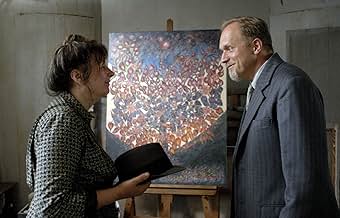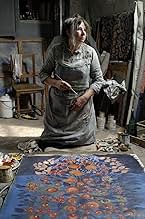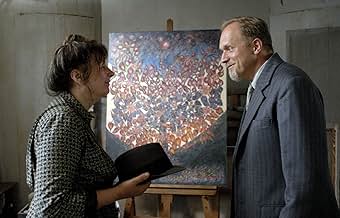CALIFICACIÓN DE IMDb
7.4/10
6.6 k
TU CALIFICACIÓN
Basada en la vida de la pintora francesa, Séraphine de Senlis.Basada en la vida de la pintora francesa, Séraphine de Senlis.Basada en la vida de la pintora francesa, Séraphine de Senlis.
- Premios
- 20 premios ganados y 7 nominaciones en total
Léna Breban
- Soeur Marguerite
- (as Léna Bréban)
Sandrine Bodenes
- Marie-Louise
- (as Sandrine Bodènés)
Anne Benoît
- Madame Delonge
- (as Anne Benoit)
- Dirección
- Guionistas
- Todo el elenco y el equipo
- Producción, taquilla y más en IMDbPro
Argumento
¿Sabías que…?
- TriviaSince the film's release, the number of visitors at the museum of Senlis exhibiting Séraphine's works has quadrupled (August 2009).
- ErroresWilhelm Uhde is portrayed as having a goatee beard throughout the course of the film. Portraits of him show generally a clean-shaven man or one with the small moustache.
- Créditos curiososThe credits list the names of the paintings which are seen in the film - 10 paintings by Séraphine and the artworks owned by Uhde and Kolle.
- Bandas sonorasConsonent laudes!
Written by Louis Rousseau
Performed by Yolande Moreau, Françoise Lebrun and Léna Breban
Opinión destacada
Séraphine de Senlis - born Séraphine Louis (1864- 1942) - may not be a painter well known to the entire art world today, but the story of her life makes a compelling film. Writer Marc Abdelnour and writer/director Martin Provost have extracted all of the significant aspects of Séraphine Louis' life and have created a work of art as a film, much in the style of the way she created her life in art.
Séraphine Louis (Yolande Moreau) was born in 1864 in Arcy to a poor family and worked as a shepherdess until 1881 when she accepted the position as a domestic worker for the Sisters of Providence in Clermont: her life with the nuns enhanced her profoundly religious approach to her personal philosophy. In 1901 she left the convent, in part due to a communication with her angel that she must paint, to become a housekeeper for middle class families in Senlis. In her quiet manner she scrubbed floors and did laundry by day, using the pittances of income to procure some supplies so that she could paint her images of fruits, flowers, and leaves by candlelight at night in her tiny room. Self taught, she used pigment from strange sources - blood from the butcher, melted wax from the votives at the cathedral, pollen from the flowers of the fields, her only 'purchased' component was gesso and white paint from the artist supply shop in Senlis.
In 1914 the German art collector and critic Wilhelm Uhde (Ulrich Tukur) took a room in the house owned by Mme Duphot (Geneviève Mnich), one of the houses where Séraphine worked, and when Wilhelm discovered a painting by Séraphine he immediately recognized a painter of great promise and provided Séraphine with the first response to her artistic efforts. Wilhelm and Séraphine became friends and Wilhelm bought all of her art, insisting that she devote her time to creating art instead of scrubbing floors. With the backing of a collector and friend, Séraphine began painting in earnest, showing locally and selling art under Wilhelm's sponsorship, until 1914 when with WW I breaking out, Wilhelm had to flee France, leaving behind his collection of paintings as well as the close bond the two had formed. Mistakenly Séraphine thought Wilhelm's departure was to marry his roommate Anne-Marie (Anne Bennett), only to discover that Anne-Marie was Wilhelm's sister and fellow supporter of Séraphine: Wilhelm informed her he would never be able to marry a woman.
Séraphine continued painting as she lead her eccentric life in Senlis and in 1927 Wilhelm returned to France with his paramour - young painter Helmut Kolle (Nico Rogner) who suffered from tuberculosis - rediscovers Séraphine's art in a local Senlis exhibition, and realizes that she had survived and her art had flourished. Under Wilhelm's patronage, Séraphine began painting large canvases as large as two meters high, and she achieved prominence as the naïve painter of her day. In 1929, Wilhelm organized an exhibition, 'Painters of the Sacred Heart', that featured Séraphine's art, launching her into a period of financial success she had never known - and was ill prepared to manage. Then, in 1930, with the effects of the Great Depression destroying the finances of her patrons, Wilhelm had no choice except to stop buying her paintings. Séraphine's spending habits cause concern and in 1932 her psychotic behavior resulted in placement in the psychiatric ward in Clermont hospital where she spent the rest of her days, alone and without friends or admirers of her gift of art.
The simplicity of the manner in which this story is related with very little dialogue, atmospheric scenery as captured by cinematographer Laurent Brunet, and a musical score by Michael Galasso that combines sacred chants with idiomatic instrumental music of French ancestry. Yolande Moreau glows with a special radiance as the simple, spiritual, artistically driven Séraphine and Ulrich Tukar is the perfect balance as his own driven, unique 'first true collector'. This film is a little masterpiece and one that deserves the attention of everyone who cares about the lives of artists and the emergence of genius from strange vessels.
Grady Harp
Séraphine Louis (Yolande Moreau) was born in 1864 in Arcy to a poor family and worked as a shepherdess until 1881 when she accepted the position as a domestic worker for the Sisters of Providence in Clermont: her life with the nuns enhanced her profoundly religious approach to her personal philosophy. In 1901 she left the convent, in part due to a communication with her angel that she must paint, to become a housekeeper for middle class families in Senlis. In her quiet manner she scrubbed floors and did laundry by day, using the pittances of income to procure some supplies so that she could paint her images of fruits, flowers, and leaves by candlelight at night in her tiny room. Self taught, she used pigment from strange sources - blood from the butcher, melted wax from the votives at the cathedral, pollen from the flowers of the fields, her only 'purchased' component was gesso and white paint from the artist supply shop in Senlis.
In 1914 the German art collector and critic Wilhelm Uhde (Ulrich Tukur) took a room in the house owned by Mme Duphot (Geneviève Mnich), one of the houses where Séraphine worked, and when Wilhelm discovered a painting by Séraphine he immediately recognized a painter of great promise and provided Séraphine with the first response to her artistic efforts. Wilhelm and Séraphine became friends and Wilhelm bought all of her art, insisting that she devote her time to creating art instead of scrubbing floors. With the backing of a collector and friend, Séraphine began painting in earnest, showing locally and selling art under Wilhelm's sponsorship, until 1914 when with WW I breaking out, Wilhelm had to flee France, leaving behind his collection of paintings as well as the close bond the two had formed. Mistakenly Séraphine thought Wilhelm's departure was to marry his roommate Anne-Marie (Anne Bennett), only to discover that Anne-Marie was Wilhelm's sister and fellow supporter of Séraphine: Wilhelm informed her he would never be able to marry a woman.
Séraphine continued painting as she lead her eccentric life in Senlis and in 1927 Wilhelm returned to France with his paramour - young painter Helmut Kolle (Nico Rogner) who suffered from tuberculosis - rediscovers Séraphine's art in a local Senlis exhibition, and realizes that she had survived and her art had flourished. Under Wilhelm's patronage, Séraphine began painting large canvases as large as two meters high, and she achieved prominence as the naïve painter of her day. In 1929, Wilhelm organized an exhibition, 'Painters of the Sacred Heart', that featured Séraphine's art, launching her into a period of financial success she had never known - and was ill prepared to manage. Then, in 1930, with the effects of the Great Depression destroying the finances of her patrons, Wilhelm had no choice except to stop buying her paintings. Séraphine's spending habits cause concern and in 1932 her psychotic behavior resulted in placement in the psychiatric ward in Clermont hospital where she spent the rest of her days, alone and without friends or admirers of her gift of art.
The simplicity of the manner in which this story is related with very little dialogue, atmospheric scenery as captured by cinematographer Laurent Brunet, and a musical score by Michael Galasso that combines sacred chants with idiomatic instrumental music of French ancestry. Yolande Moreau glows with a special radiance as the simple, spiritual, artistically driven Séraphine and Ulrich Tukar is the perfect balance as his own driven, unique 'first true collector'. This film is a little masterpiece and one that deserves the attention of everyone who cares about the lives of artists and the emergence of genius from strange vessels.
Grady Harp
- gradyharp
- 17 jul 2010
- Enlace permanente
Selecciones populares
Inicia sesión para calificar y agrega a la lista de videos para obtener recomendaciones personalizadas
- How long is Seraphine?Con tecnología de Alexa
Detalles
Taquilla
- Presupuesto
- EUR 3,674,000 (estimado)
- Total en EE. UU. y Canadá
- USD 884,613
- Fin de semana de estreno en EE. UU. y Canadá
- USD 38,637
- 7 jun 2009
- Total a nivel mundial
- USD 9,402,702
- Tiempo de ejecución2 horas 5 minutos
- Color
- Mezcla de sonido
- Relación de aspecto
- 1.85 : 1
Contribuir a esta página
Sugiere una edición o agrega el contenido que falta

Principales brechas de datos
By what name was Séraphine (2008) officially released in India in English?
Responda

































